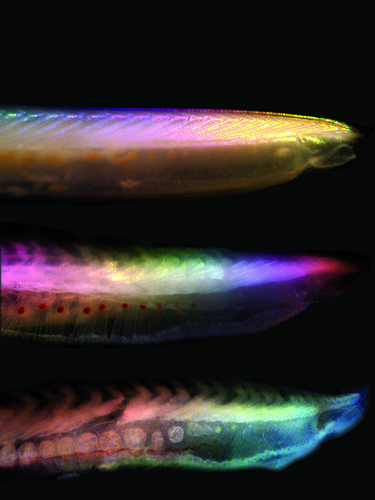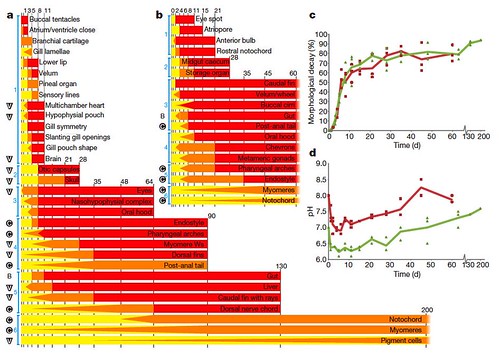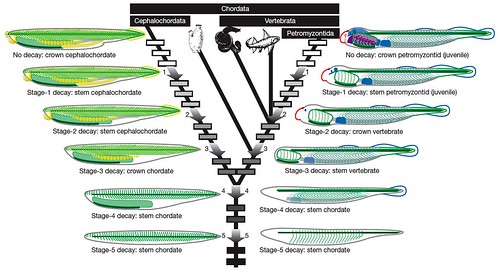tags: evolutionary biology, paleontology, fossils, fossilization, fossil forensics, Taphonomy, taxonomy, zoology, deep time, paleoceanography, amphioxus, Branchiostoma lanceolatum, lamprey, Lampetra fluviatilis, chordates, researchblogging.org,peer-reviewed research, peer-reviewed paper
Three rotting Amphioxus heads.
A sequence of images showing how the characteristic features of the body of amphioxus, a close living relative of vertebrates, change during decay. Colours are caused by interference between the experimental equipment and the light illuminating the specimens.
Image: Mark Purnell, Rob Sansom, Sarah Gabbott, University of Leicester.
[larger view]
DOI: 10.1038/nature08745
How do you know what something looks like when you've never seen it before? This is the question that paleontologists deal with every day: describing the appearance of ancient animals based on incomplete information gathered from small fossilized fragments of those animals. As if that is not difficult enough, they also use this incomplete information about physical appearances to build family trees that describe the evolution of these animals.
A team of paleontologists from the University of Leicester devised a new method for extracting information from 500 million year old fossils: they studied the rate and sequence of decomposition for individual physical features to better understand how our ancient fish-like ancestors might have originally looked. The team's findings indicate that some of the earliest vertebrate fossils may have been more evolutionarily advanced than previously thought.
"It seems contradictory, but decomposition is an important part of the process by which animals become preserved and fossilized," explained paleontologist Robert Sansom from the University of Leicester in the UK, who led the research. "By knowing how these important anatomical features change as they rot, we are better able to correctly interpret the most ancient fossils representing the lowest branches of our part of the evolutionary tree."
Fish-like fossils from 500 million years ago form the early, basal, portion of our evolutionary heritage because they possess characteristic physical features, such as two eyes, a tail, and the precursor to a spine, known as a notochord (Figure 1).
Figure 1 | Phylogeny and anatomy of chordates. a, Deuterostome phylogeny based on data from extant forms. Asterisks mark the extant proxies used in the experiments. Each fossil taxon (coloured) has been proposed to have a wide range of affinities, with little consensus existing. b, Cephalochordate anatomy (top) and ammocoete anatomy (bottom). C, chordate synapomorphy; V, vertebrate synapomorphy. [larger view]
DOI: 10.1038/nature08745
"The idea that characters are lost -- especially in soft-tissue creatures -- to decomposition is not a novel idea," remarked Leicester team member Mark Purnell, a paleobiologist in the Geology Department at the University of Leicester, UK.
Up until now, paleontologists relied upon the assumption that decaying bodies lose their identifying characteristics in a random order. The Leicester team decided to test this hypothesis by carefully documenting how modern boneless fish -- similar to the early ancestors of humans -- decay. Their findings show that this assumption is in error.
To conduct this simple yet elegant study, the team collected adult amphioxus, Branchiostoma lanceolatum and juvenile lamprey, Lampetra fluviatilis, from the wild and killed them. The researchers placed the bodies into clear plastic boxes filled with saltwater, sealed the lids, and incubated them at 25 degrees Celsius for up to 200 days, recording the changes that the decaying bodies experienced (video).
Adult lamprey decomposition: 200 days in 36 seconds.
Three specimens of each species were destructively sampled at different time intervals to document rapid early decay as well as the later, slower stages of decomposition. The Leicester team recorded the decay process for each anatomical feature both visually and via dissection, and scored observed changes according to a simple rating system: pristine (same condition as at death), decaying (morphology altered from its original state) or lost (no longer present, or present but unrecognizable). These data were then analyzed (Figure 2).
Figure 2 | Results of experimental decay. a, Anatomical characters of larval Lampetra ranked according to last occurrences in decay sequence (horizontal scale shows time in days). Observations are scored as pristine (yellow), decaying (orange), onset of loss (red) or complete loss (terminal point). Plesiomorphic characters are labelled for Chordata (C), Vertebrata (V) and Bilateria (B). Decay stages are indicated in blue. b, Character decay for adult Branchiostoma (as in a). 'Storage organ' has been historically termed 'fin rays'. c, Quantitative morphological decay through time for Lampetra (green) and Branchiostoma (red). d, pH changes through time for Lampetra (green) and Branchiostoma (red); initial pH differences reflect salinity. Lines connect means in c and d; d, days. [larger view]
DOI: 10.1038/nature08745
These data revealed a surprisingly consistent pattern of decomposition throughout time. This pattern shows that as these modern fish decayed, the most recently evolved features -- those characters that are most informative because they distinguish closely related animals within the same lineage -- rotted first. The last features to disappear were more ancient; those that are shared by all vertebrates, such the notochord.
These findings raise important questions regarding just how "primitive" the early ancestors of vertebrates were 500 million years ago.
"The issue is: is a character not present because it was never there or is it that the character was there and had rotted away," explained Dr Purnell. "In cases where all we have are [fossils of] decay resistant structures, we have to be very careful."
The Leicester team documented this pattern of character loss so other scientists could better interpret the most ancient marine fossils.
Based on their data, the team proposed that misinterpretation of decayed fossils led to "stem-ward slippage" where organisms are classified as more basal than they really were (Figure 3).
Figure 3 | Morphological decay stages of Branchiostoma (left) and larval Lampetra (right) and the phylogenetic position of each stage if interpreted as a fossil. Rectangles on branches of the phylogeny are morphological characters, their shade indicating order of loss (white, early; dark, late). As each organism decays, its phylogenetic position moves down the tree; thus, taphonomic bias exists in identification of fossil chordates. Characters are colour coded according to the hierarchical level for which they are informative (green, chordate; yellow, cephalochordate; blue, vertebrate; purple, cyclostome and vertebrate (sensu DOI: 10.1666/06-130.1); red, petromyzontid). [larger view]
DOI: 10.1038/nature08745
This misinterpretation of some fossil materials might contribute to "a widespread but currently unrecognized bias in our understanding of the early evolution of a number of phyla" because failure to recognize that some important features might have disappeared before fossilization. This can be interpreted to suggest that many ancient animals belonged to very primitive and bizarre groups when they might actually have shared more features with modern animals than previously thought.
"In some organisms that have been interpreted there has been way too much speculation and the data have been extended beyond what is scientifically acceptable," Dr Purnell stated. He also pointed out earlier in a review paper that it is important to recognize that some fossil organisms are simply too just incompletely preserved for their evolutionary significance to be realized (DOI: 10.1002/bies.200800128).
Further, this study lends support to the hypothesis that many early vertebrate groups experienced short, rapid bursts of evolutionary change followed by long periods of basic tinkering of forms.
I think this study is interesting because, as a molecular biologist, I had no idea that the decay sequence followed by dead animal bodies had not already been worked out. For that reason alone, this study is long overdue. Additionally, I find it fascinating to learn that the sequence in which an animal's distinguishing features are lost to decay is not random, and appears to follow a reverse-phylogenetic pattern.
"We need to understand how they decayed if we're going to put them in the right place in the tree of life," agrees Dr Purnell. "The work doesn't appeal to everyone, but it's worth the effort."
NATURE video report.
Source:
Sansom, R., Gabbott, S., & Purnell, M. (2010). Non-random decay of chordate characters causes bias in fossil interpretation. Nature DOI: 10.1038/nature08745 [many thanks to Henry Gee, senior editor at Nature, for responding to my request to make this PDF open access. It will be freely available to the public for the next two weeks].
Also see:
Donoghue, P., & Purnell, M. (2009). Distinguishing heat from light in debate over controversial fossils. BioEssays, 31 (2), 178-189 DOI: 10.1002/bies.200800128





Cool! Hooray for open access!
So decomposition recapitulates phylogeny -- fascinating!
(One question: since when are Branchiostoma termed "fish"?)
There are parts of a fish that are more distorted by decomposition than others. The abdominal region, for instance, can be severely distorted by decomposition gasses formed in the gut. Parts of the skull, thoracic & caudal spine, pelvic girdle, on the other hand, undergo relatively little distortion. Morphometric analysis of fossil fish is typically based on markers in these less distorted regions.
Question for Mike Keesey: Which bit of 'ancient fish-like ancestor' did you not understand?
palaeobill - in fairness Grrl does use "Fish" in her title. Fetid fish-like ancestors" doesn't have the same ring, alas.
darwinsdog - what you say may well be true, but we are not talking morphometrics or distortion of bodies here. The results of our decay work concern the sequence of loss of phylogenetically informative anatomical characters.
seriously, i see these titles and i think Yong!
Cool. It's the Body Farm for fish.
great post! Nasty taphonomy at it's best. It reminds of a paleontology class where the teacher presented a study by a colleague that decided to check how coprolites were formed by making a parrot crap on trays full of various sediments. The parrot was someone's mother's pet...
the title is the work of my own twisted mind. but if you must know, each piece i write has somewhere between 10-20 titles before i finally settle on one that i like (either that or i finish the story and the title it has at that point is the one it's stuck with).
this is a question another reader asked (i hope you're still out there, mark purnell);
Is this to be understood that more recent features rot more easily, or that those features are thought to be more recent becuase they rot more easily?
On the issue of being entombed in mud (post 11 â a good point), our animals were rotted in relatively small containers, so they couldn't float away; they pretty much trotted where they sat (take a look at the lovely lamprey video). But there is a more important point here regarding experiments: the process by which an organism becomes a fossil is a complex interaction between a number of variables, including decay, burial, the nature of the sediment in which it is buried, the chemistry of the water flowing through that sediment, etc. etc. If we try to study all these variables at once, we don't have a hope of understanding what's going on because we won't know which variables are causing the patterns of decay/preservation we observe. The way to build up an understanding of the whole process is to start simple: we need to understand decay in a simple experimental system, without sediment, before we can understand what the effects of sediment and other variables might be.
each piece i write has somewhere between 10-20 titles before i finally settle on one that i like
Did you consider "A fish rots from the head down"? ;)
Dr. Parnell, I'm the one who asked about the entombment. Would encasing the corpse in an inert, clear gel like ballistics gel simulate the conditions of burial without causing extraneous variables?
Thanks for taking the time to answer my original question. This study has me very curious.
Will they try this experiment with various amounts of sedimentary mud or sands covering the dead material. That could also change the rates of decomposition. My only fear is this simple re-adjusted thinking in researched paleontological finds would be used to say there has never been any evolved animals, all animal fossils found had fully formed modern appendages that just rotted fast......during the FLOOD in 6000yrs.